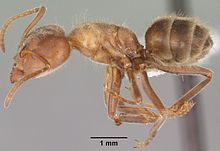Liometopum apiculatum
| Liometopum apiculatum | |
|---|---|
 |
|
| L. apiculatum worker from the United States | |
| Scientific classification | |
| Kingdom: | Animalia |
| Phylum: | Arthropoda |
| Class: | Insecta |
| Order: | Hymenoptera |
| Family: | Formicidae |
| Genus: | Liometopum |
| Species: | L. apiculatum |
| Binomial name | |
|
Liometopum apiculatum Mayr, 1870 |
|
| Synonyms | |
|
|
Liometopum apiculatum is a species of ant in the subfamily Dolichoderinae. Liometopum apiculatum ants are found in arid and semi-arid regions of southwestern United States and Mexico to Quintana Roo.
Liometopum apiculatum was first described by Mayr (1870), who described the workers of this species. Emery (1895) later described the queens of this species; Wheeler (1905) described the males and Wheeler & Wheeler (1951) described the larvae. Shattuck (1994) considered L. apiculatum a senior synonym of Liometopum masonium. This species was also confirmed by Del Toro et al. (2009).
Liometopum apiculatum ants are found in arid and semi-arid regions of southwestern United States and Mexico to Quintana Roo. They extend from Colorado through Texas, New Mexico, southeastern Arizona, and south into Mexico. They are usually found at elevations of 1,000–2,500 metres (3,300–8,200 ft), but their prime habitat is oak forests found around 2,000 m (6,600 ft). At higher elevations they are found in pinyon pine zones, up to the ponderosa pine and riparian zones; at lower elevations they inhabit creosote bush scrub and grasslands in microhabitats of clay, under rocks, boulders, and decaying logs. They have also been found in foothill meadows, deciduous canyon forests, pinyon-cedar woodlands, ponderosa pine-cedar-oak woodlands, and cottonwood–willow forests. At high elevations, their abundance decreases and they are replaced by L. luctuosum. Altitude may play an important role in the distribution of Liometopum. In regions of Mexico explored by Conconi et al. (1983b), L. luctuosum and L. apiculatum are only found between 2,000 and 3,000 m (6,600 and 9,800 ft). Although conditions below 1,800 m (5,900 ft) looked favorable, they are absent. In the U.S., L. apiculatum is found from 1,316 to 2,438 m (4,318 to 7,999 ft).
...
Wikipedia
